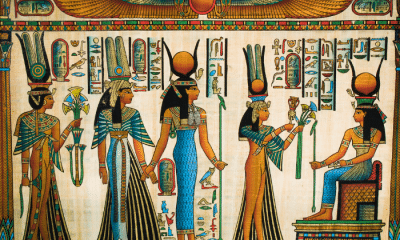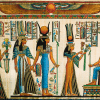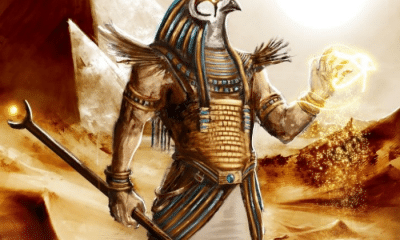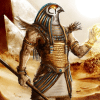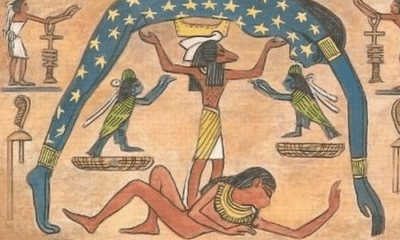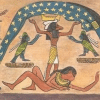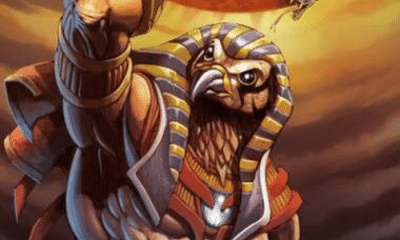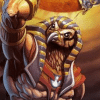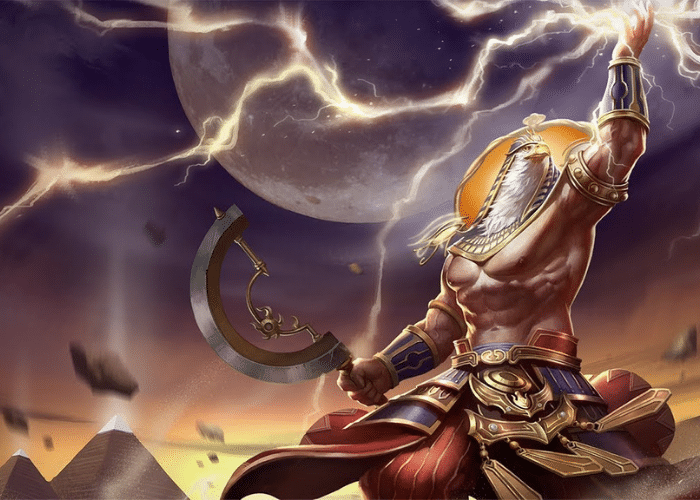
Egyptian
The Egyptian Sun God Ra
The Egyptian Sun God Ra
Surrounded by desert, the people of ancient Egypt believed that the sun was the most important aspect of the universe. Here’s everything you need to know about Ra, the Egyptian solar god.
According to many Egyptian legends, the sun was the source of all life.
While they depended on the Nile for agriculture and trave, the people of ancient Egypt saw the sun as the main creative force. It was consistent and powerful, while the availability of water varied.
Many gods were associated with the sun. Ra was the foremost of these and was often said to have been the creator of mankind.
Despite his power, however, Ra was often associated with other gods. He shared his domain and even his throne with many other deities, but famous and little-known.
Often shown as a powerful king with the disc of the sun above his head, Ra took many forms and names in his role as Egypt’s father god.
The Origin Myth of Ra
Over the course of thousands of years of their culture’s history, the Egyptians often changed the details of their myths. While the gods remained relatively consistent the stories concerning them did not.
This is in part because the people of ancient Egypt put much less emphasis on the actions of the gods than other cultures often did. The most popular stories of the gods, at least among surviving writings, focus more on their roles in the afterlife than in creation.
Because of this, our understanding of the Egyptian creation myth is often less well-understood than other aspects of their religion.
There are two versions of the story of Ra’s birth, both of which begin with Nun.
Nun was the primordial void that was the only thing in existence before the first gods were created. It was an infinite sea without thought or consciousness.
In one version of the story, a spark of consciousness took form in Nun. This became Ra, who willed himself into existence out of nothingness.
In another version of the story, it was Amun who came into existence. Along with Ptah, the god of crafts, he created an egg that floated in Nun. From this egg, Ra was born.
Like Ra his first children also had no mother. He created twins, Shu and his sister Tefnut.
Shu became the god of dry air while Tefnut represented mists and moisture. The twins also represented the passage of time, with the dry air of Shu preserving things over time and Tefnut’s humidity causing decay.
As air deities, however, Shu and Tefnut did not remain by their father. They quickly floated away and disappeared.
The Creation of Man and the Gods
Ra searched for his children, but because there was no light it was impossible to find them. The aid in his search he pulled out one of his own eyes and cast it upwards to provide light.
Rather than remain with a single eye, Ra created another to replace the one he had pulled out. When his eye returned, it was jealous that it had been replaced.
To appease his eye, Ra made his new one dimmer. His first eye became the sun while the second was the moon.
As Ra searched for his children he began to weep, either from grief or frustration. These tears became the first men.
Ra soon saw that these men had land to walk on and his eyes had a sky to move through. Shut and Tefnut had given birth to two children, the earth god Geb and the sky goddess Nut.
Ra hoped to marry Nut but she had already fallen in love with Geb. Although their father Shu, the air, tried to keep them apart she refused to marry Ra instead.
Ra was infuriated and decreed that Nut would not have a child on any day of any month of the year. This curse was meant to keep her from ever having children, but Ra did not know that it would be ineffective.
Thoth had been playing a board game with Khonsu, the god of the moon. Whenever the moon god lost he gave up a little of his light.
By the time they had finished playing Thoth had enough light to add five days to the lunar year. Because of this, the moon was out of sync with the solar calendar and five days had to be added to the end of the year.
These extra five days did not belong to any month so they fell outside of Ra’s curse. Nut gave birth to Osiris, Isis, Set, Nephthys, and Horus and Ra remained unmarried.
Ra’s Retirement
Although it was said to have come from his body, the sun was called the Eye of Horus in most Egyptian sources. This is because Ra eventually abdicated power.
In some stories the succession of divine kings fell into a natural order. First Geb, then Osiris, took power until it was passed down to the second Horus, Osiris and Isis’s son.
In another, however, Isis conspired to have her son inherit Ra’s eye directly from its source.
A book of spells from the 12th century BC combined mythology, medicine and magic to address daily concerns. The spells were said to come from Isis and the stories recorded explained how they originated.
In one, Isis wanted to learn Ra’s secret name. He went by many names, including Ra which was the word for the sun, but his secret name would give power to anyone who used it.
By this time Ra was old and growing weak, and like many elderly people he kept a very predictable daily routine. Every day he took a walk to survey his lands, so Isis placed a snake at a crossroads she knew he would pass.
Ra was immune to most snakebites, but this snake’s venom had been made from his own essence. He was badly wounded and called all the gods together to find a cure.
None of the gods knew how to cure the snakebite except for Isis. She offered to cure him but demanded knowledge of his secret name as payment.
Ra tried to avoid this by answering with a riddle:
I am the maker of heaven and earth,
I am the establisher of the mountains,
I am the creator of the waters,
I am the maker of the secrets of the two horizons.
I am the light and I am darkness,
I am the maker of the hours, the creator of days.
I am the opener of festivals,
I am the maker of running streams,
I am the creator of living flame.
I am Khepri in the morning, Ra at noontime, and Atum in the evening.
Isis was unmoved, however, and insisted on hearing the name in exchange for a cure. Ra finally relented and whispered the name to Isis.
The incantation Isis recited was included in the story. It was believed that it would be as effective on human patients as it had been on the god.
Once he was cured, however, Isis asked for another payment. Her son Horus would one day be king and she wanted him to have both of Ra’s eyes, the sun and the moon.
Merged Gods
When Horus took the kingship, he became the new sun god.
Horus and Ra were often associated with different aspects of the sun. Horus was the younger king so he was the god of the sunrise, while the venerable Ra was the god of the midday sun.
In some parts of Egypt, Horus and Ra were therefore very closely associated with one another. The sun god sometimes went by the name Ra-Horakhty, or “Ra the Horizon Horus.”
This was not the only god who came to be associated with Ra, however. Some were so closely linked that they became interchangeable.
They included:
- Amun – He was a wind deity to created life through breath. By the Fifth Dynasty, the two beings had merged into the widely-venerated Amun-Ra. Amun, or Ammon in Greek, was sometimes named in place of Ra in later sources.
- Raet – Also called Raet-Tawy, she was a female aspect of Ra. She is rarely mentioned in Egyptian writings and her relationship to Ra was unclear.
- Atum – Another solar god, he often features instead of Ra in the story of Tefnut and Shu’s creation. They were often worshipped together as Atum-Ra or Ra-Atum.
- Khepri – The representation of the rising sun was not a god but a giant scarab beetle who rolled the sun disc over the horizon.
- Khnum – The opposite of Khefri, Khnum was the god of the setting sun. The ram-headed god was also given as an alternative for the creator of man as the god of pottery and the source of the Nile.
- Aten – The cult of Aten was a short-lived attempt by the pharaoh Akhenaten to make the minor deity the principal god of all Egyptians. Akhenaten merged Amun-Ra with his personal god, sometimes calling him Aten-Ra to promote his cult.
- Montu – Originating in Thebes, Montu was the chief god of Upper Egypt. While he was originally associated with stars, his position as the counterpart of Amun, the god of Lower Egypt, led to him being called Montu-Ra.
- Osiris – When he traveled through the Underworld, Ra was believed to merge with Osiris.
Over time, Ra’s position as the god of the sun was diminished to that of only the midday sun. While he remained prominent and important, other deities shared domain over the sun at various times of the day.
Ra, however, retained the sun in his iconography and imagery. He was shown with the sun disc above his head and cosmology often featured him, or his eye, moving across the daytime sky.
And images of what happened after the sun set featured Ra as well.
Ra In the Underworld
Many of the Egyptian gods had ties to the Underworld.
Egyptian religion was largely focused on what happened to the soul after death. The best-preserved documents from the area are funerary texts and elaborate tomb writings, all of which feature the gods.
There were some gods and beasts said to solely inhabit the Underworld, but virtually all of the gods had dealings with that realm. The gods were capable of death and rebirth just like humans and many also traveled to the Underworld for specific purposes.
As the solar deity, Ra’s link to the Underworld was his disappearance at night.
When the sun went below the horizon in the evening, the Egyptians believed that it traveled to the Underworld. Ra, in essence, died each night and was reborn every morning.
The Egyptians believed that he traveled on two boats, one during the day and one at night. To go through the Underworld he traveled on Mesektet, the boat of the evening.
He merged with Osiris, another former god king who had become the ruler of the Underworld after his own death. The pharaohs also merged with Osiris at death, so Ra’s journey represented the entirety of kingship in the afterlife.
In the Underworld, Ra often took on a ram-headed form. This may be the origin of his identification with Khnum, who also had the head of a ram.
Rams were also identified with strength, which Ra needed for his nightly journey through the land of the dead. Every night, he was attacked by the serpent Apophis.
Apophis, or Apep, embodied chaos and destruction and his goal was to devour Meseket so the sun could not rise again in the morning. Every night Osiris-Ra fought him off, often with help from other gods.
The violent god Set was often said to accompany Ra through the Underworld. He often fought off the monstrous Apophis.
Mehen, a protective snake, was said to fight off other monsters of the Underworld.
Storms that arose at night were sometimes said to be Ra and Set fighting Apophis in the Underworld.
By the time of the New Kingdom, it was believed that Ra could also help the living communicate with the dead. When people gave blessings to the souls of the dead, Ra carried them in his ship each night.
Pharaohs and the Pyramids
As a one-time king, Ra was also closely associated with mortal kingship in Egypt.
It is not known when the kings of Egypt began to refer to themselves as incarnations of Horus. This became a common convention, however, and the pharaohs were eventually revered as gods in human form.
In the Fourth Dynasty, inscriptions referred to the kings as “Sons of Ra.” Fifth Dynasty rulers sometimes said that they were specifically the sons of Ra and the priestess of his temple at Heliopolis.
In the Middle Kingdom the pharaohs became more closely affiliated with Osiris and Horus, but their connection to the original sun deity remained strong.
Throughout most of Egyptian history, the pharaohs including “Son of Ra” as part of their name. This was a title given to them at birth and considered part of their personal name.
Ra’s name was also included in the pharaoh’s throne name, or prenomen. While historians usually refer to the pharaohs by their personal names, without the Son of Ra title, the throne name was what would have been used during the king’s reign in official contexts.
Thus in both their private and public lives, the pharaohs associated themselves with Ra through their names.
They also did so in their building projects. While the state supported many of Egypt’s gods, the solar deity always received special recognition from the pharaohs.
Monumental architecture was one way in which kings in the ancient world ensured their legacies, Rulers in ancient Egypt focused on buildings that venerated the sun.
Because of their connection to Ra and Horus the pharaohs funneled vast resources into temples and monuments to the sun. Egypt’s many obelisks, for example, were designed as monuments to the sun.
According to some Egyptologists, the pyramids also served as enormous symbols of the sun’s power.
Because Ra traveled through the Underworld each night, he was considered to be an important protector of the dead as well as a symbol of pharaonic power. The pyramids rose to the sun to connect the souls of the pharaohs to their ancestor.
One interpretation of the construction of the pyramids was that the soul of the king would be able to ride to Ra on the sun’s rays as they hit the structure’s tip. When they were first built the pyramids were capped with god to catch the light of the sun.
Many people also believe that the pyramid complex at Giza was built with the sun’s movements in mind. Historians have theorized that the Giza complex was designed to align with the sun at various times of the year.
Ra the Sun
Ra was the principal solar god of Egyptian religion.
He was said to have been one of the first, if not the first, god to emerge from nothingness. He became the ancestor of many of the religion’s other powerful gods including Osiris, Horus, and the earth god Geb.
In these legends he is also a creator god. Many myths say that the first humans were formed from his tears.
The sun and moon were made from his eyes. The most powerful of these, the sun, became a symbol of kingship.
Ra was the first king of the Egyptian gods and ruler of their land. Power eventually passed to other gods, including Horus who took Ra’s place as the keeper of the eye of the sun.
As the ancestor of the gods and the first king, Ra was also seen as an ancestor of the pharaohs. Their names and monuments cite Ra as their father and glorify his power.
Ra was often associated with other Egyptian gods, including those who had also been kings. These deities were often referred to by a shared name and seen as other aspects of the sun’s power.
Ra was also an Underworld god, like many in Egyptian religion. When the sun set at night he traveled through the Underworld, fighting chaos until he was reborn in the morning.


